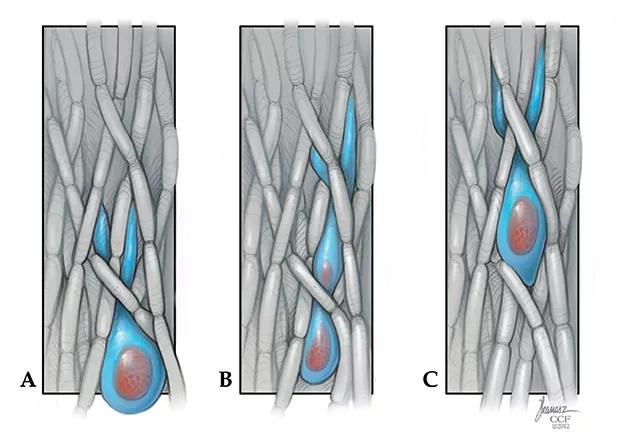Advertisement
Targeting myosins and kinesins to block tumor proliferation

Patients with glioblastoma and other malignant brain tumors have some of the greatest unmet needs of any population with cancer. Despite recent therapeutic advances, survival rates remain dishearteningly low. Yet there’s no shortage of new approaches to glioblastoma treatment now being investigated at Cleveland Clinic and other major centers.
Advertisement
Cleveland Clinic is a non-profit academic medical center. Advertising on our site helps support our mission. We do not endorse non-Cleveland Clinic products or services. Policy
One of the most intriguing approaches involves targeting the activity of molecular motors — the “tiny protein machines…that are responsible for most forms of movement we encounter in the cellular world,” as Schliwa and Woehlke described them in a 2003 Nature review.
Like the motor of a car engine, molecular motors cause malignant glial cells to move through the brain’s white matter and cortex (Figure). Intervening in or inhibiting the activity of these motors stops the cells from moving, opening the door to a new area of drug development for glioblastoma.

Figure. Schematic of a glioma cell (blue) migrating through brain white matter, which consists largely of oriented axons (sausage-shaped gray structures). Tumor cell migration occurs in two steps: Forward protrusion of a long finger of cell cytoplasm is followed by squeezing of the cell body, containing the cell nucleus (red), in a process that requires the molecular motor known as nonmuscle myosin II.
Cleveland Clinic researchers, led by Steven Rosenfeld, MD, PhD, believe that molecular motors such as myosins and kinesins are underappreciated as potential therapeutic targets for blocking both tumor cell proliferation and migration in glioblastoma.
Dr. Rosenfeld’s team recently showed that inhibiting one molecular motor, the kinesin KIF11, with a small molecule blocked proliferation and invasion of glioblastoma cells and lengthened survival in mouse models of the malignancy. These findings, reported in Science Translational Medicine, identified KIF11 as a high-interest therapeutic target for treating glioblastoma, especially given the availability of a KIF11 inhibitor that is safe for use in humans.
In the wake of that study, Cleveland Clinic is collaborating with the German biopharma company 4SC to launch a phase 2 trial of a new KIF11 inhibitor for patients with newly diagnosed and recurrent glioblastoma. The trial is expected to begin enrollment by early 2017, with Cleveland Clinic as the sole U.S. site.
The team is also studying other molecular motors, including myosin II and myosin X, both of which are targetable with small molecules currently in development, but human studies are not imminent.
“Very few groups are working in this niche,” says Dr. Rosenfeld, a neuro-oncologist in the Rose Ella Burkhardt Brain Tumor and Neuro-Oncology Center and Director of the Brain Tumor Research Center in Cleveland Clinic Lerner Research Institute. “Our lab is well suited to pursue this because our staff combine over 25 years of clinical practice in neuro-oncology with expertise in the enzymology of molecular motors, specifically in glioblastoma.”
Advertisement
Advertisement

First-of-its-kind clinic for immune-related adverse events supports oncologists in managing severe side effects

Novel therapy “retrains” the brain to disrupt pain signals

An underdiagnosed condition in patients with cancer

Study demonstrates superior visualization of occult primary lesions

New device offers greater tumor control for malignant liver lesions

Cleveland Clinic researchers discover what drives – and what may halt – virus-induced cancer

First-ever U.S. population-level retrospective analysis reveals many patients with systemic mastocytosis need faster intervention

New program provides prehabilitation and rehabilitation services to help patients with cancer maintain and regain function